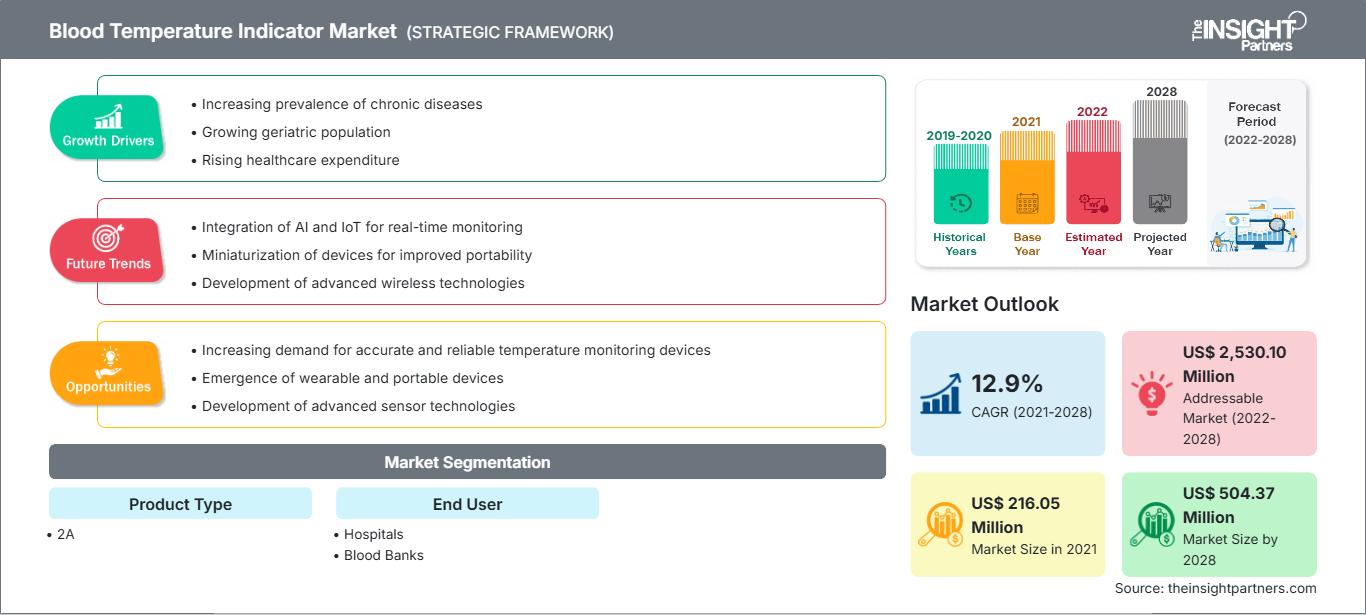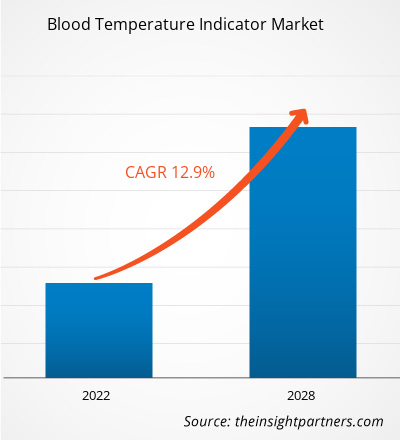Se espera que el mercado de indicadores de temperatura sanguínea crezca de US$ 216,05 millones en 2021 a US$ 504,37 millones en 2028; se estima que registrará una CAGR del 12,9% de 2021 a 2028.
Los indicadores de temperatura sanguínea son pequeños dispositivos o soluciones médicas que contribuyen a aumentar la seguridad sanguínea mediante el transporte eficaz y eficiente de la sangre y sus componentes. Estos indicadores proporcionan una prueba auditable de que la sangre se almacena y transporta conforme a las normas regulatorias, lo que reduce aún más el desperdicio de sangre.
El informe proporciona información y un análisis profundo del mercado de indicadores de temperatura arterial, haciendo hincapié en diversos parámetros como las tendencias, los avances tecnológicos y la dinámica del mercado. También proporciona un análisis del panorama competitivo de los principales actores del mercado y el impacto de la pandemia de COVID-19 en el mercado de indicadores de temperatura arterial en las principales regiones. La pandemia de COVID-19 ha alterado las condiciones socioeconómicas de varios países del mundo. Según las estadísticas de la OMS de 2021, Estados Unidos es el país más afectado del mundo debido a la pandemia de COVID-19, con el mayor número de casos. El alto número de casos ha afectado la economía de América del Norte, especialmente la de Estados Unidos. La pandemia de COVID-19 ha provocado cambios tecnológicos cruciales para brindar una mejor atención médica. Debido a la propagación del SARS-CoV-2, muchas ciudades están cerradas, lo que ha provocado la cancelación de tratamientos médicos y cirujanos. La pandemia de COVID-19 ha afectado la fabricación y el suministro de indicadores de temperatura arterial debido a la interrupción de la cadena de suministro a nivel mundial. Además, los profesionales de la salud están priorizando los procedimientos de emergencia y cancelaron todas las cirugías electivas para prevenir la propagación del coronavirus.
En 2020, la Administración de Alimentos y Medicamentos (FDA) autorizó el uso de emergencia de plasma convaleciente para el tratamiento de pacientes con COVID-19, lo que impulsó un aumento en la donación de sangre. Además, se espera que la presencia de importantes actores del mercado y sus diversas colaboraciones estratégicas en el mercado de indicadores de temperatura sanguínea impulsen el crecimiento del mercado. Por ejemplo, Timestrip, desarrollador de tecnología de indicadores inteligentes, está lanzando una gama completamente nueva con dos indicadores electrónicos de temperatura. Estos indicadores serán fundamentales para supervisar el almacenamiento y el transporte seguros de diversos productos, como productos farmacéuticos, vacunas, atención médica, alimentos, adhesivos y tintas. Por lo tanto, la pandemia de COVID-19 afectó negativamente al mercado de indicadores de temperatura sanguínea.
Según la región, el mercado de indicadores de temperatura sanguínea está segmentado en América del Norte, Europa, Asia Pacífico, Medio Oriente y África, y América del Sur y Central.
Obtendrá personalización en cualquier informe, sin cargo, incluidas partes de este informe o análisis a nivel de país, paquete de datos de Excel, así como también grandes ofertas y descuentos para empresas emergentes y universidades.
Mercado de indicadores de temperatura arterial: Perspectivas estratégicas

-
Obtenga las principales tendencias clave del mercado de este informe.Esta muestra GRATUITA incluirá análisis de datos, desde tendencias del mercado hasta estimaciones y pronósticos.
Perspectivas del mercado
El aumento de las transfusiones y donaciones de sangre impulsa el mercado de indicadores de temperatura sanguínea
La transfusión de sangre es uno de los procedimientos más comunes en el cuidado de la salud, que ayuda a mantener el nivel de sangre de los pacientes. Hay varias condiciones crónicas, procedimientos quirúrgicos y casos de trauma que requieren transfusión de sangre para que los pacientes puedan sobrevivir sin efectos secundarios debido a niveles bajos de sangre. Las condiciones médicas, incluyendo talasemia, cáncer de sangre, anemia de células falciformes, anemia y casos quirúrgicos y traumáticos, conducen a pérdida de sangre y requieren una transfusión de sangre. Según la organización de la Cruz Roja Americana, ~16 millones de componentes sanguíneos se transfunden cada año en los EE. UU. Además, la anemia de células falciformes afecta a 90,000-100,000 personas en los EE. UU.; ~1,000 bebés nacen con esta enfermedad cada año. Por lo tanto, la creciente prevalencia de enfermedades crónicas ha creado la demanda de transfusión de sangre, que se espera que impulse el crecimiento del mercado de indicadores de temperatura sanguínea.
Tras su extracción, la sangre debe almacenarse y transportarse en condiciones y temperaturas específicas. Si la sangre se almacena y transporta fuera del rango de temperatura específico durante un tiempo prolongado, pierde su capacidad para transportar oxígeno, lo que puede causar graves problemas. Además, existe el riesgo de contaminación bacteriana grave si la sangre se expone a altas temperaturas. Los indicadores de temperatura sanguínea desempeñan un papel importante en el mantenimiento de las condiciones y la temperatura necesarias para el transporte seguro y fiable de la sangre y sus componentes. Monitorear cuidadosamente la temperatura y mantener la sangre segura durante el transporte reduce el riesgo de deterioro de la sangre. Por lo tanto, el aumento de las transfusiones y donaciones de sangre, y la creciente demanda de transporte seguro de sangre y sus componentes, genera una demanda de indicadores de temperatura sanguínea, lo que impulsa el crecimiento del mercado.
Información basada en el tipo de producto
Según el tipo de producto, el mercado de indicadores de temperatura sanguínea se segmenta en rangos de 2 °C a 4 °C, de 5 °C a 7 °C y superior a 7 °C. En 2021, el segmento de 2 °C a 4 °C representó la mayor participación de mercado. Su posición en el mercado ha aumentado debido a su uso principal durante el transporte de sangre en largas distancias. Por ejemplo, según las principales directrices europeas y estadounidenses, la temperatura de las bolsas de glóbulos rojos debe estar entre 1 °C y 6 °C durante el almacenamiento y entre 1 °C y 10 °C durante el transporte.
Perspectivas regionales del mercado de indicadores de temperatura sanguínea
Los analistas de The Insight Partners han explicado detalladamente las tendencias regionales y los factores que influyen en el mercado de indicadores de temperatura arterial durante el período de pronóstico. Esta sección también analiza los segmentos y la geografía del mercado de indicadores de temperatura arterial en América del Norte, Europa, Asia Pacífico, Oriente Medio y África, y América del Sur y Central.
Alcance del informe de mercado de indicadores de temperatura sanguínea
| Atributo del informe | Detalles |
|---|---|
| Tamaño del mercado en 2021 | US$ 216,05 millones |
| Tamaño del mercado en 2028 | US$ 504,37 millones |
| CAGR global (2021-2028) | 12,9% |
| Datos históricos | 2019-2020 |
| Período de pronóstico | 2022-2028 |
| Segmentos cubiertos |
Por tipo de producto
|
| Regiones y países cubiertos |
América del norte
|
| Líderes del mercado y perfiles de empresas clave |
|
Densidad de actores del mercado de indicadores de temperatura arterial: comprensión de su impacto en la dinámica empresarial
El mercado de indicadores de temperatura arterial está creciendo rápidamente, impulsado por la creciente demanda del usuario final debido a factores como la evolución de las preferencias de los consumidores, los avances tecnológicos y un mayor conocimiento de los beneficios del producto. A medida que aumenta la demanda, las empresas amplían su oferta, innovan para satisfacer las necesidades de los consumidores y aprovechan las tendencias emergentes, lo que impulsa aún más el crecimiento del mercado.

- Obtenga una descripción general de los principales actores clave del mercado de indicadores de temperatura arterial
Información del usuario final
Según el usuario final, el mercado de indicadores de temperatura sanguínea se segmenta en hospitales, bancos de sangre y otros. El segmento hospitalario dominó el mercado en 2021.
Los actores del mercado de indicadores de temperatura sanguínea adoptan estrategias orgánicas como el lanzamiento y la expansión de productos para expandir su presencia y cartera de productos a nivel mundial.
Perfiles de empresas
- Elitech
- Thero Fisher Scientific Inc.
- Sercalia
- Grupo Ellab
- Corporación Zebra Technologies
- Tecnologías de Lisaline Lifesciences
- Stream Peak International PTE Ltd
- 3M
- DeltaTrak Inc.
- TimeStrip UK Ltd
- Análisis histórico (2 años), año base, pronóstico (7 años) con CAGR
- Análisis PEST y FODA
- Tamaño del mercado, valor/volumen: global, regional y nacional
- Industria y panorama competitivo
- Conjunto de datos de Excel
Informes recientes
Informes relacionados
Testimonios
Razón para comprar
- Toma de decisiones informada
- Comprensión de la dinámica del mercado
- Análisis competitivo
- Información sobre clientes
- Pronósticos del mercado
- Mitigación de riesgos
- Planificación estratégica
- Justificación de la inversión
- Identificación de mercados emergentes
- Mejora de las estrategias de marketing
- Impulso de la eficiencia operativa
- Alineación con las tendencias regulatorias






















 Obtenga una muestra gratuita para - Mercado de indicadores de temperatura sanguínea
Obtenga una muestra gratuita para - Mercado de indicadores de temperatura sanguínea